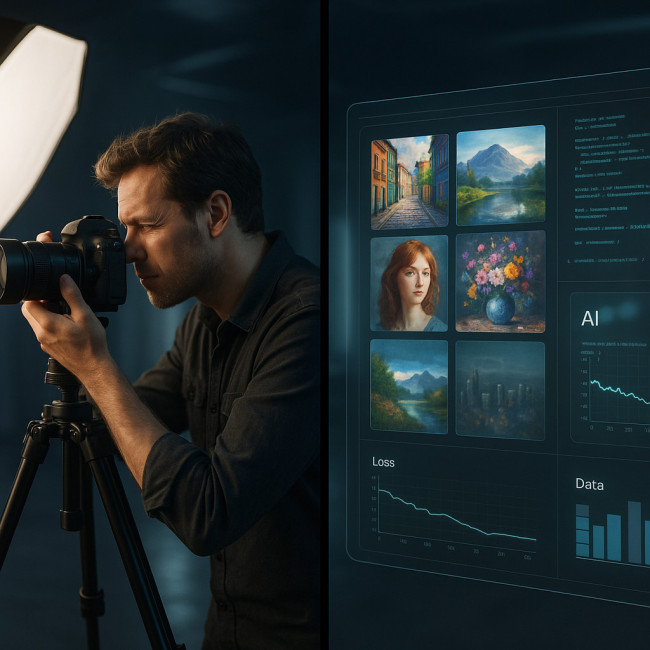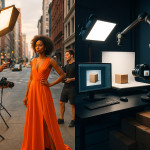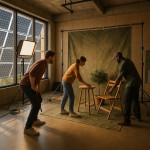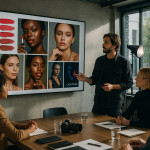AI-Generated Imagery: Due Diligence Steps Before Hiring Hybrid Photographers
AI-generated imagery opens dazzling creative horizons, yet it raises thorny legal, ethical and technical questions. This guide walks you through a rock-solid due-diligence process to hire hybrid photographers—creatives who blend traditional shooting with generative models—without exposing your brand to risk.
Why Due Diligence Matters With Hybrid Photographers

Hybrid creators harness camera craft and machine-learning tools in one pipeline. The result is fast, flexible visuals at attractive rates. However, copyright uncertainty, dataset bias and unclear disclosure can derail campaigns. Structured vetting protects budgets, timelines and brand reputation.
Step-by-Step Vetting Checklist
1. Clarify Ownership & Usage Rights
- Ask for a written statement detailing how AI outputs are trained, who owns the training data and whether any stock elements require extra licences.
- Require transfer or licensing clauses that mirror those in conventional photo contracts.
- Cross-check local laws on AI authorship. Jurisdictions differ on whether machine-generated elements qualify for copyright.
2. Screen Model & Dataset Sources
Request a dataset summary. Legitimate hybrid photographers should reveal whether training images are public-domain, proprietary, or scraped material. If personal data is involved, confirm GDPR or CCPA compliance.
3. Evaluate Technical Workflow Transparency
- Invite candidates to present a process deck showing where AI enters the pipeline, from prompt engineering to post-production.
- Look for version control. Time-stamped files help prove authorship if disputes arise.
- Check colour-management steps; AI imagery often needs extra profiling to match print or broadcast specs.
4. Demand Style Consistency Tests
Run a mini brief. Supply brand guidelines and ask for three variations—one camera-only, one AI-only, and one hybrid. Compare tonal coherence, noise levels and retouching finesse.
5. Verify Equipment & Skill Sets
A solid hybrid pro still masters lighting, lenses and on-set direction. Inspect gear lists and previous campaign credits. For more tips, see our architecture photographer hiring checklist.
6. Check Directory & Community Reputation
Browse Artfolio's verified photographer directory for badges, testimonials and portfolio freshness. A strong rating signals reliability.
7. Audit Ethical Statements
- Bias mitigation: do they monitor gender, race and body representation in their AI prompts?
- Environmental impact: do they prefer energy-efficient compute or cloud credits?
- Disclosure policy: final images should include an “AI-assisted” tag when required by ad regulations.
8. Insist on Disaster-Recovery Plans
If cloud generators go offline, can the shooter replicate looks in-camera? In fast-moving commerce, fallback scenarios are essential. Learn how live calendars reduce last-minute chaos in this availability guide.
Comparing Pure, Hybrid and Fully Generated Imagery
| Factor | Camera-Only | Hybrid | AI-Only |
|---|---|---|---|
| Turnaround speed | Medium | Fast | Very fast |
| Budget flexibility | $$$ | $$ | $ |
| Legal clarity | High | Medium | Low |
| Creative control | Full | High | Variable |
| Authenticity perception | High | Medium-High | Medium |
Hybrid solutions balance cost and authenticity but require deeper due diligence, especially around legal clarity.
Contract Clauses You Should Never Skip
Once you select a hybrid shooter, tighten your contract:
- Scope of AI use: Define which tools (e.g., Stable Diffusion, Firefly) are permitted.
- Indemnification: The photographer covers any third-party infringement claims.
- Audit rights: You can inspect raw files and prompts if disputes surface.
- Destruction of unlicensed data: Ensures non-compliant training sets are removed.
- Attribution guidelines: Control how AI-generated imagery credits appear in campaign collateral.
Red Flags During Portfolio Review
Watch for:
- No EXIF data on supposed “camera” shots.
- Over-smooth skin and repetitive textures, hinting at heavy AI use without disclosure.
- Inconsistent lighting direction across composite elements.
- Stock-like faces recurring in multiple portfolios. They may stem from the same public model.
For additional optimisation strategies, read how to optimise your photographer directory profile.
Integrating AI Workflows Into Your Brief
1. Provide Clear Prompts
Add sample prompts in the brief to steer generative outputs toward brand tone. Example: “Hyper-real macros of recycled textiles under studio daylight, emphasising weave texture.”
2. Lock Colour References Early
Share Pantone codes and LUTs. AI generators may drift; fixed references align camera and synthetic passes.
3. Request Layered Deliverables
PSD or EXR files with isolated AI layers speed future edits and legal audits. Explore how AI mock-ups empower iterative approvals in this mock-up deep dive.
Quiz: Test Your Hybrid Photographer Hiring IQ
FAQ
- Do AI-generated images need model or property releases?
- If the AI recreates a recognisable person or location, treat it like traditional photography and secure releases or swap prompts.
- Can hybrid photographers guarantee exclusivity?
- Yes, when they fine-tune private models on your proprietary assets and avoid public datasets.
- Will AI imagery pass social-media ad verification?
- Platforms vary. Facebook now requests disclosure tags for heavily generated visuals. Always check current ad policies.
- How long does due diligence add to lead time?
- With a clear checklist, you add two to three business days, far less than fighting infringement claims later.
Key Takeaways
- Hybrid photographers offer speed and creativity but introduce new compliance layers.
- Demand transparent datasets, audit rights and clear ownership clauses.
- Use mini test briefs to gauge style consistency and technical rigour.
- Align AI prompts, colour references and layered exports from the outset.
- Structured due diligence protects campaigns, budgets and brand equity.
Ready to brief a hybrid creator? Nail your internal planning first, then browse our directory tips on commissioning specialised photography to keep your search efficient.
Action Steps
Download the checklist, update your standard contract, and schedule a discovery call with vetted talent today. Solid prep leads to bold, legally safe imagery that resonates.











